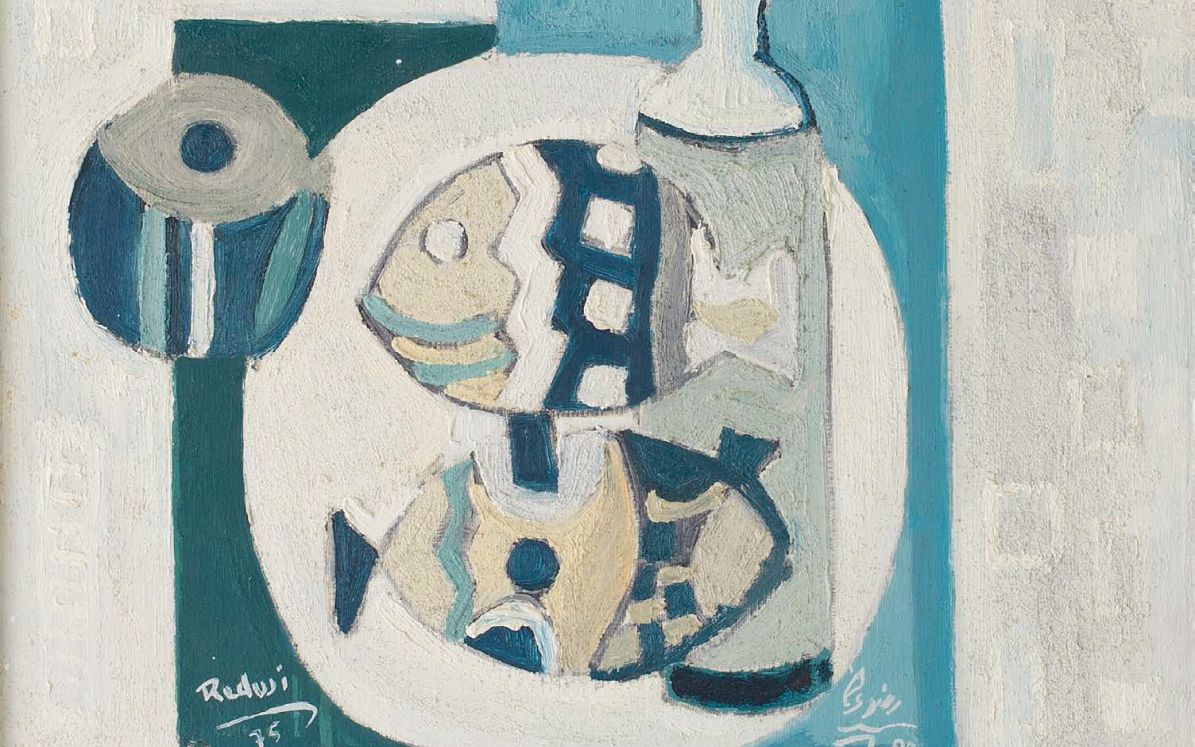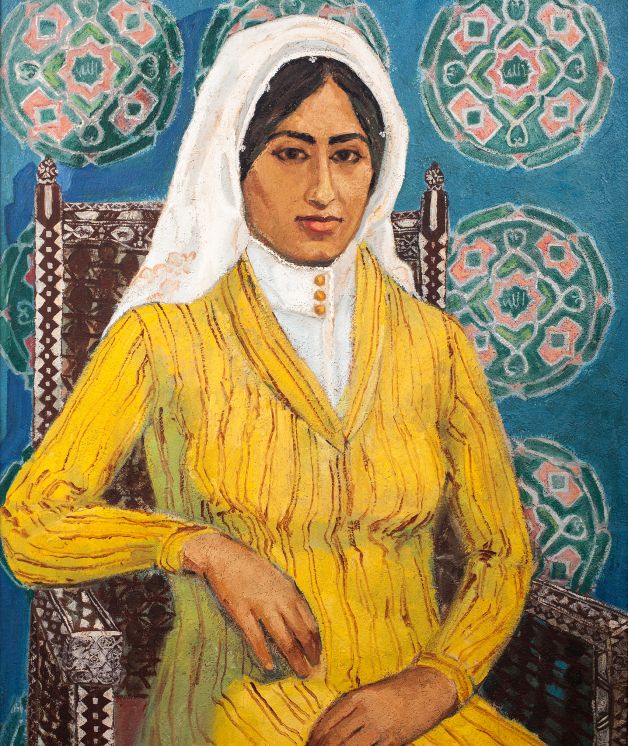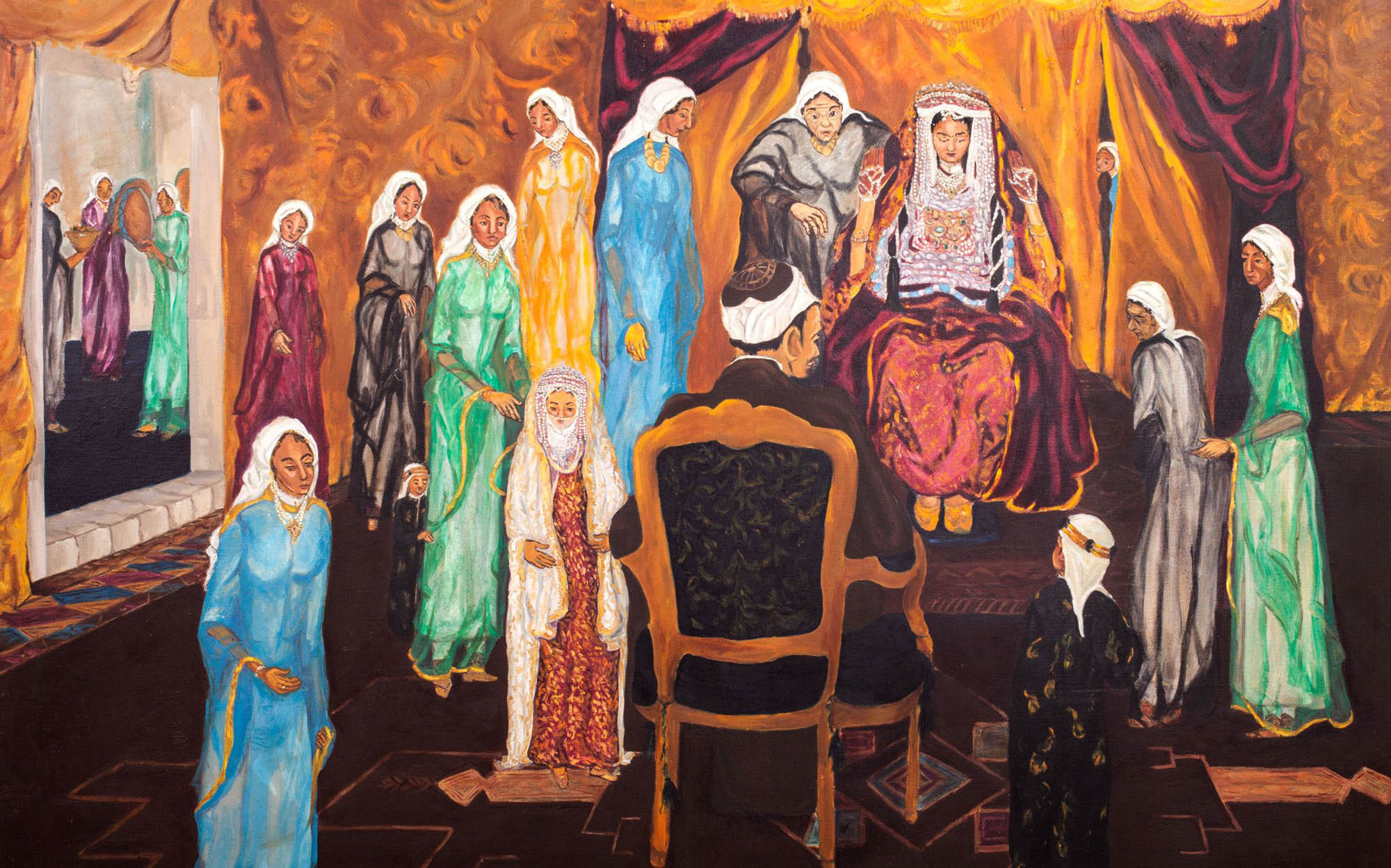The mountains, the myths and the mosquitos
Hemsedal, Norway. Photo by Anne Katrine Senstad
A Norwegian lives by nature, for nature and with nature. From the silent forests of trolls to the halls of the mountain king, all the way back to the Viking era and beyond, nature represents simultaneously an embodiment of eternity as it clears the path to the riddles of life.
From the kaleidoscopic lights in the sky, also known as the Aurora Borealis, the unruly North Sea and white midsummer nights, myths, music, poetry and stories are born and reborn.
Here I share some of Norway’s cultural gems and interpreted art in the national color of blue.

Viking illustration, warrior and shield from Sagas of Kings by Snorre. The shield depicts the King Olav’s favorite horseman and warrior, Ragvald Vognstyreren Heidum-Hår.

Traditional Viking pattern, horse head, from Sagas of Kings by Snorre. The horse was an important companion of the Viking.
The early Norwegian Vikingr, the Norse word for Viking, have many legends and stories, and extensive literary excursions encompassed of verse, rhyme and prose that follow paths of long winding family histories crossing valleys and fjords (long, deep, narrow bodies of water that reach far inland), boisterous bloodthirsty battles out at sea, trade all the way to the Far East and Northern Africa bringing back gold coins, textiles and elaborately decorated swords. The mockery of their enemies, tricking them into their certain demise is bragged about in short verse.
Trolls in the Viking era were born from the rich mythology of Odin and Thor, representing darkness and death, ever still, a force to conquer in battle in the underworld. “I have never seen bodies as nearly perfect as theirs. As tall as palm trees, fair and reddish, they wear neither tunics nor kaftans. Every man wears a cloak with which he covers half of his body, so that one arm is uncovered. They carry axes, swords, daggers and always have them to hand. They use Frankish swords with broad, ridged blades.”
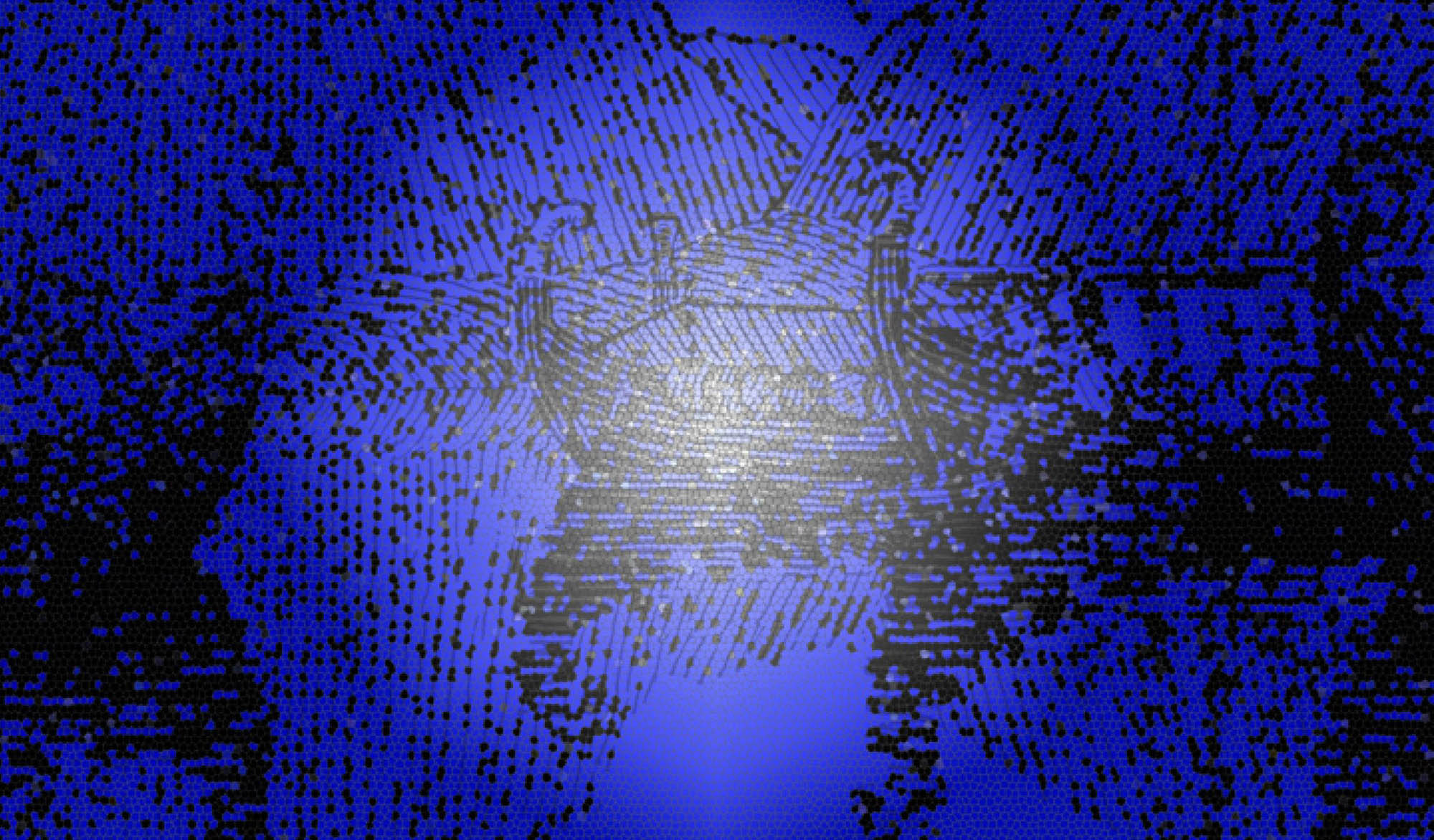
Interpretation: On the fjord, the return home of the Viking Ship fleet. By Anne Katrine Senstad
So the Arab traveller Ahmad Ibn Fadlan recorded his meeting more than 1,000 years ago with a strange race he called the “Rusiyyah,” now commonly known as Vikings. Ibn Fadlan first met the Norse warriors as they travelled across the Russian steppes, sailing their longships down the Volga river and looking to trade with the Arab world.
A mysterious character, the real Ibn Fadlan was a key member of a diplomatic mission sent by Abbasid Caliph Al Muqtadir in 921 from Baghdad
to the upper reaches of the river Volga, in answer to a request for diplomatic assistance from the king of Volga Bulgaria.

Dragon embroidery, from The Sagas of Kings by Snorre
Hans Børli (1918 -1989) was a poet and lyricist who captured the heart of the Norwegian relationship with nature through his language. With a humble approach to the vernacular, Børli transcends the essence of the human condition through the everyday moment and eternal cycles of life. Børli was a school teacher, who lived and labored in the forest all his life. I have reinterpreted these poems by Børli shared here, in homage to his timeless prose.

From my window. By Anne Katrine Senstad.

In the Forest. photo By Anne Katrine Senstad.

Encountering a tree troll. When walking in the forest, beware of trolls, witches and gnomes, some are lucky and will tell you secrets, and some will put spells on you, pulling you into the underworld.Photo/illustration by Anne Katrine Senstad
Nothing vanishes.
All forevermore engraved
on eternity’s tablets.
If a bird flies through the setting sun
two people exchange some friendly
words
by the mailbox one morning, or
a trail is gently blanketed in virgin
snow,
then these minute things
will be kept in universal consciousness
as long as days break in the east,
night descends mercifully over Earth.
There is a vast memory out there in
space,
an all-embracing memory
that cancels Time
and unites all things
in a single star-white Instant.
A forest whispering is like the
sound of
A bird in flight.
Breathing the wind of wings
Of hope and dreams and
longing
That keeps the earth floating in
space
Despite the growing weight
of war and blood
And despair
The second poem by Børli was written during the German occupation of Norway in the 1940s when Børli was active in the resistance and conveys his sadness for war. I was inspired to reinterpret the poem responding to our present time, yet keep it’s timeless innocence in tone and respectful of the original. To read more poems from the poet, click here.
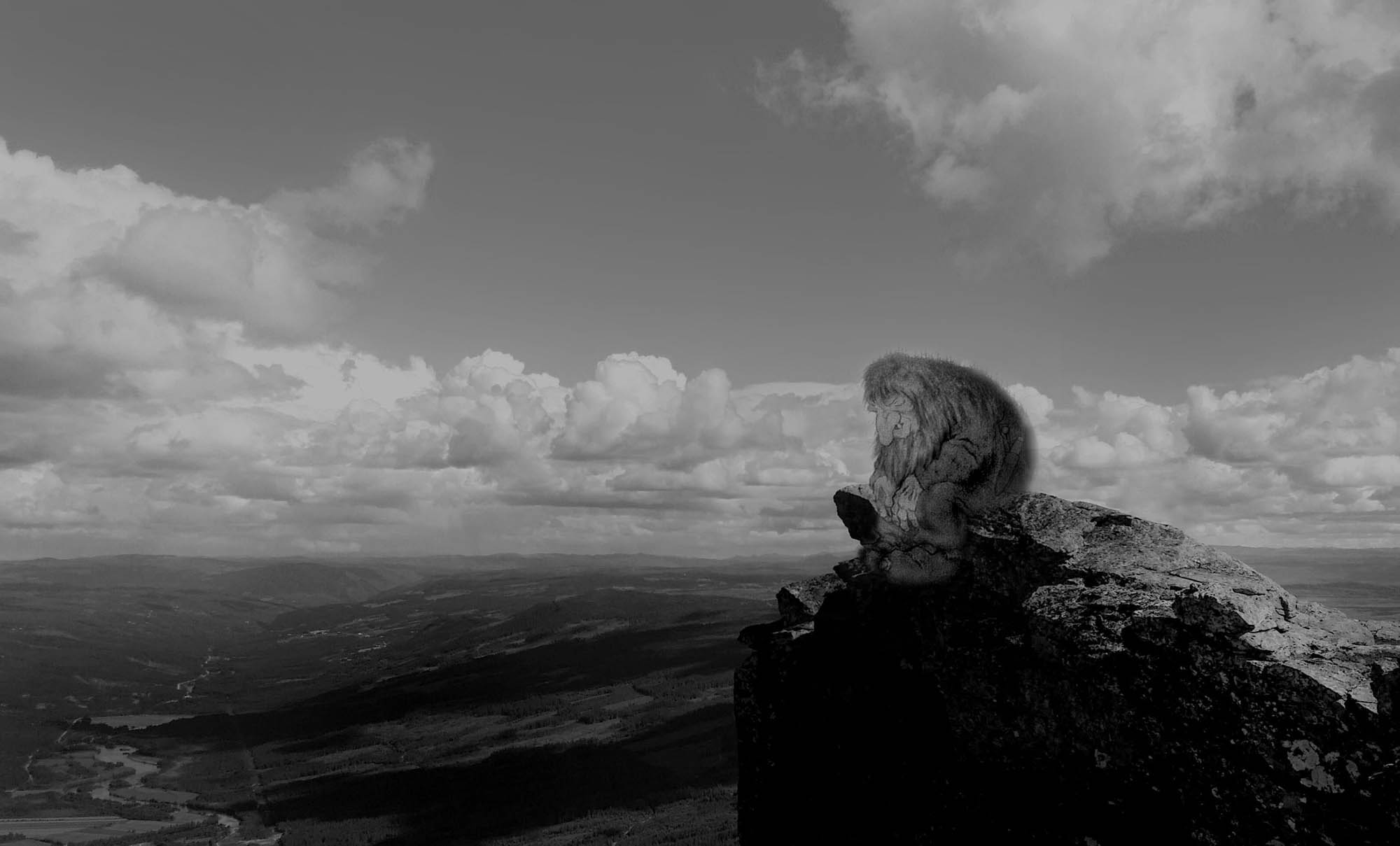
Photo by Anne Katrine Senstad with the iconic illustration by Theodor Severin Kittelsen (1914-1857) “The Troll contemplating his age.” The troll contemplating age is ironic since they have no age, they are known to be dumb and worry heads – Kittelsen’s illustration is about how we as humans worry about life. I put him on the very edge of a mountain peak in Hemsedal, as if sitting on the roof of his house. Trolls live inside mountains if they are small like this fellow, and if they are large, they are the actual mountain itself. In that case, the mountain is a sleeping Troll not to be awakened – the other ironic point with the illustration is it refers to the sculpture “The Thinker” by Rodin – so it’s a human trait to think, to contemplate, to philosophize and worry.
Trolls are mythological human looking figures that vary in size personality and in relation to a natural phenomenon. They are generally an embodiment of all bad things in human beings as in greed fear violence and laziness vices one has to flight within oneself or one meets on the path of life But trolls can also be considered gullible pets to play with due to their slowness or cheeky characters Trolls allow us to express what we can’t or shouldn’t say or do. The largest known trolls are giants, the size of mountains, merged with the mountain itself, with trees growing on his back and head, spending their lives asleep as a mountain until it rises when woken, in a bad mood stumbling about, angrily in a daze looking for trouble and human blood. This type is considered the most dangerous
The slightly smaller troll, but still a giant the size of the super ape King Kong or a mythical Cyclops, is the affluen wealthy troll who lives inside a mountain known as a Mountain Hall Kingdom. This type of troll sleeps in a pile of gold coins and holds court to numerous variations of lesser trolls and gnomes, One of the most famous trolls is a three headed troll, the size of the tallest pine trees where the three heads argue with each other and their story is that they can never agree, determined to lose the battle and in the end, it is always outsmarted by a folk character known as Askeladden. Through Askeladden we learn how to conquer a troll in order to not get eaten alive when we take its gold and conquer its land. Askeladden’s secrets in fighting trolls include outsmarting them by asking them trick questions riddles or competitions
In the fairytale of Ash Lad and the trolls who competed, the trolls are said to represent nature and its riches in raw form while Ash Lad represents human resourcefulness, trade and ownership. Ash Lad is an 18th century cultural archetype deeply embedded in the Norwegian psyche, but his brave ways and sense of humor can be traced back to the Viking sagas. He is the youngest son on a farm characterized by being an underdog and misunderstood by the world. But nevertheless, he is full of optimism in the face of adversity. When presented with impossible tasks, he always wins in the end against all odds while achieving the highest goals possible, often by outsmarting his opponents with his wit, charm and imagination. This series of fairy tales are full of trolls, princesses and mythology that are widely used as symbolic of moral encouragement and faith in the inherent good in people.

Illustration by Anne Katrine Senstad, based on a traditional illustration from the fairytale: Askeladden and the Troll who competed. The illustration is inspired by German painter Gerhard Richter’s paintings of events and history that are often blurred and dreamy

Illustration: Reindeer with traditional Sámi sun circle (indigenous symbol of the Laplanders/ Sámi people). Artwork by Anne Katrine Senstad.
In Sámi culture, the indigenous peoples who have inhabited the north since ancient times, the reindeer with the mightiest antlers is the leader and the king. The trolls here can be a rock in a brook or river and the Sámi sing to them and share stories about them, as well as embody their characteristics through the Joik – the Sámi traditional song. All nature is alive and is respected. In Joik you vocalize the ode by personifying it, singing how wind and rivers are our helpers, how the mountain feels pain or how the reindeer is magical.
In Norway the preservation of the Sámi indigenous culture and language occurs through contemporary art, film and music, often based on the ancient poems and storytelling. The ways of Sámi are eternal and timeless, yet adaptable to any cultural or technological evolution today and tomorrow. A children’s version of the Joik is a Joik of the mosquito, sang with the high-pitched voice of the mosquito, whose necessity for blood preserves the cycle of life, teaches the child of the ways of all things in nature and their true characteristic.
Above the arctic circle the sun never sets, it is a 24 hour day for three months, while in southern Norway the midsummer nights appear as a velvety blue twilight at the darkest hours. The eternal midnight sun is literally heaven for the swarms of monstrous mosquitos that start to appear around midsummer, making the mosquito a very present part of everyday life for the people in northern Norway. The northern Mosquito is not to be confused with the smaller tropical mosquito.

Illustration: Reindeer with traditional Sámi sun circle (indigenous symbol of the Laplanders/ Sámi people). Artwork by Anne Katrine Senstad.
The son of the wind has advanced
The daughter her self is pushing from
the end
If I haven’t arrived by midsummer
I will come
Even with a cain.
I sting you because your blood is so
sweet
I sting you because through this minute
sting you are alive
But the day when the crows become
white,
I will be done with my task
That is my promise of certainty for the
cycle of life
Traditional Sami Joik, approximately
dating to: 500 B.C.
(An ancient song that survived orally, the nomadic Sámi people don’t have a written tradition like the Vikings did, yet story telling has preserved their cultural memory. Sámi culture is very sophisticated and contemporary in numerous ways)
Have a listen here to one interpretation of this song about an annoying mosquito.
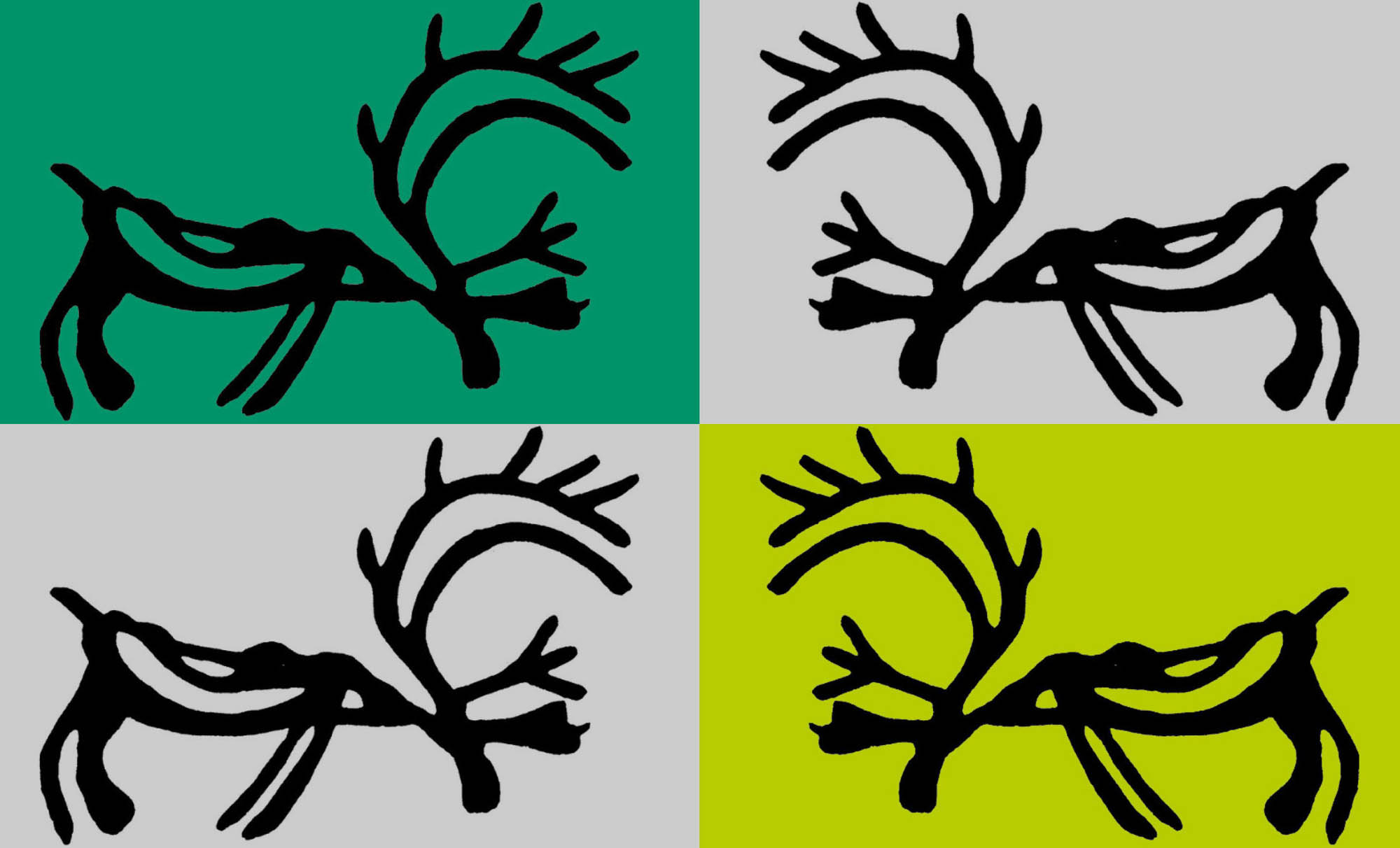
Traditional ancient reindeer illustration, Sámi. Artwork by Anne Katrine Senstad.
Anne Katrine Senstad is a Norwegian artist based in New York. She has exhibited widely internationally including the Venice Biennale, Bruges Art and Architecture Triennale, He Xiangning Art Museum, Kai Art Center, Athr Gallery, ISEA Dubai 2014 and numerous other institutions, as well as projects in Saudi Arabia. Permanent public art commissions include The Wolfe Center for the Arts designed by Snøhetta Architects.

Traditional ancient reindeer illustration, Sámi. Artwork by Anne Katrine Senstad.
